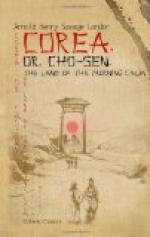The little girls under ten years of age are exceedingly pretty. With the hair carefully parted in the middle and tied into two tresses at the back, a little green jacket and a long red skirt, they do indeed look quaint. You should see how well-behaved and sedate, too, they are. It is impossible to make one smile. You may give her sweets, a toy, or anything you please, but all you will hear is the faintest “Kamapso,” and away she runs to show the gift to her mother. She will seldom go into fits of merriment in your presence, but, of course, her delight cannot fail to be at times depicted in her beaming eyes. She is more unfortunate than her brother in the number of toys she receives, and though her treatment is not so very severe, she begins from her earliest years a life of drudgery and work. As soon as her little brain begins to command her tiny fingers, she is compelled to struggle with a needle and thread. When her fragile arms get stronger she helps her mother in beating the clothes, and from the moment she rises to the time she goes to rest, ideas as to her future servility, humility, and faithfulness to man are duly impressed upon her.
As in Japan, so in Corea, a custom prevails of adopting male children by parents who have none of their own. The children adopted are generally those of poorer friends or of relations who chance to have some to spare. When the adoption is accomplished, with all the rules required by the law of the country, and with the approval of the king, the adopted son takes the place of a real son, and has a complete right of succession to his adoptive father in precedence to the adoptive mother and all the other relations of the defunct.
The Corean boy begins to study when very young. If the son of a rich man, he has a private tutor; if not, he goes to school, where he is taught the letters of the Corean alphabet, and Chinese characters. All official correspondence in Corea is done with Chinese characters, and a lifetime, as everybody knows, is hardly enough to master these. The native Corean alphabet, however, is a most practical and easy way of representing sounds, and I am not sure but that in many ways it is even more practical than ours. I will give the reader the opportunity of judging of this for himself by-and-by (see chapter xiii.). Arithmetic is also pounded into the little heads of the Cho-sen mites by means of the sliding-bead addition-board, the “chon-pan,” a wonderful contrivance, also much used in Japan and China, and which is of invaluable help in quick calculation. The children are made to work very hard, and I was always told by the natives that they are generally very diligent and studious. A father was telling me one day that his son was most assiduous, but that he (the father) every now and then administered to him a good flogging.
“But that is unfair,” said I. “Why do you do it?”
“Because I wish my son to be a great man. I am pleased with his work, but I flog him to encourage(?) him to study better still!”




